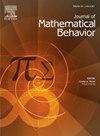两个大学生是如何用例子和欧拉图来做出和证明猜想的
IF 1.7
Q3 EDUCATION & EDUCATIONAL RESEARCH
引用次数: 0
摘要
传统的本科课堂教学方法倾向于将数学定理和证明作为成品呈现,隐藏了进入其发展过程的数学活动。在这项研究中,我们在教学实验环境中为两名本科生设计了机会,让他们参与提出和证明自己的猜想的活动。我们调查了这些学生(在教师研究员的指导下)如何使用欧拉图和例子来支持他们的猜想和证明活动。学生们不断发展的欧拉图作为他们的例子的组织者,允许他们捕捉概念的特定实例和概念之间的结构关系。通过识别学生利用欧拉图演变的不同方式和他们的例子,我们为学生参与此类数学活动提供了有益的工具。本文章由计算机程序翻译,如有差异,请以英文原文为准。
How two undergraduates used examples and an Euler diagram for making and proving conjectures
Traditional approaches to undergraduate classrooms tend to present mathematical theorems and proofs as finished products, hiding the mathematical activity that went into their development. In this study, we crafted opportunities for two undergraduate students in a teaching experiment setting to engage in the activity of making and proving their own conjectures. We investigated how these students (with the guidance of a teacher-researcher) used an Euler diagram and examples to support their conjecturing and proving activity. The students’ evolving Euler diagram served as an organizer for their examples, allowing them to capture particular instances of the concepts and structural relationships between the concepts. By identifying different ways that the students leveraged this evolving Euler diagram with their examples, we provide insight about beneficial tools for students to engage in such mathematical activity.
求助全文
通过发布文献求助,成功后即可免费获取论文全文。
去求助
来源期刊

Journal of Mathematical Behavior
EDUCATION & EDUCATIONAL RESEARCH-
CiteScore
2.70
自引率
17.60%
发文量
69
期刊介绍:
The Journal of Mathematical Behavior solicits original research on the learning and teaching of mathematics. We are interested especially in basic research, research that aims to clarify, in detail and depth, how mathematical ideas develop in learners. Over three decades, our experience confirms a founding premise of this journal: that mathematical thinking, hence mathematics learning as a social enterprise, is special. It is special because mathematics is special, both logically and psychologically. Logically, through the way that mathematical ideas and methods have been built, refined and organized for centuries across a range of cultures; and psychologically, through the variety of ways people today, in many walks of life, make sense of mathematics, develop it, make it their own.
 求助内容:
求助内容: 应助结果提醒方式:
应助结果提醒方式:


